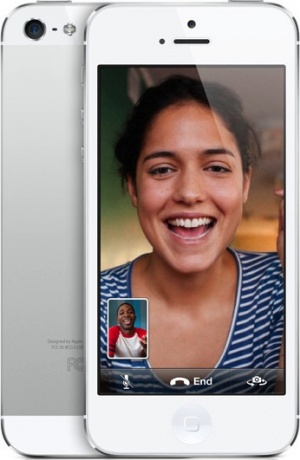FaceTime
|
FaceTime is a VoIP (Voice Over IP) video calling service from Apple, Inc. It was first developed for use with the iPhone 4's front-facing camera and later made compatible with all iOS devices with front-facing cameras, as well as Mac computers running OS X with Facetime or iSight cameras.
How It Works
FaceTime is attached to a users phone number on their iPhone 4 or later, and an email address on all other supported devices. [1] Users can click a FaceTime button in their iPhone contact lists for anyone in their contacts who has registered with the service. On other devices, users can go from the contacts or the FaceTime application itself.
When in a call, there is a button to end the call, switch cameras (front and back) and a mute button. When receiving a call users are presented with a typical call screen for iOS and can pick up or decline the call as they would for a normal call.
Supported Devices[2]
- iPhone 4 or later
- iPad 2 or later
- iPod touch (4th generation) or later
- Mac with Mac OS X v10.6.6 or later
History
When FaceTime was announced on June 24th 2010, it was wifi-only and at first only on Apple's also-new iPhone 4. During this announcement, Former Apple CEO Steve Jobs mentioned that FaceTime would be an open video calling standard, and that they would open up the standard for anybody to use. [3] This is still not the case, and FaceTime remains only available on the Apple devices listed above.
Later in 2010, Apple announced availability of FaceTime beta for its Mac computers. [4] The application was free and available to all users of Mac OS X version 10.6.6 or later.
Facetime for Mac went out of beta in February of 2011 and was $0.99. [5] Currently FaceTime is still $0.99 in the Mac App Store, although the app is included with new purchases of Mac computers.
With the introduction of iOS 6, Apple announced that FaceTime calls would no longer be only available over wifi. [6] Users can now make FaceTime calls on their iPhone's and 3G/4G-connected iPad's using their cellular network.
Ethical Implications
Before the introduction of iOS 6, it was rumored that AT&T would start charging users for FaceTime over their 3G network.[7] After the introduction of the new software, AT&T revealed that FaceTime would only be allowed on their 3G network for customers of their Mobile Share plans. [8] This distinction was called into question by several "net neutrality" watchdog groups, who then petitioned the FCC. [9] The FCC responded to these complaints, saying they would review the objections. [10] On November 8th 2012, AT&T revealed that they would be expanding mobile network usage of FaceTime to users with LTE devices on tiered data plans, but other users would still need to be on Mobile Share plans. They also revealed that they would be rolling out FaceTime over cellular to customers on more data plans in the "near future" but did not specify further. [11]
Restricting this service calls into question the ethics of a service provider restricting certain kinds traffic and what that means for the competitive landscape. If a service provider prioritizes the traffic of one application over the other, people will probably just not use the application that is restricted and find other means. In this case, Apple may lose customers who would have used FaceTime to Skype or another video calling service. Skype and several other services that provide the same video calling functionality of FaceTime, although not with the same integration into contacts, have been allowed to be used over cellular networks since before FaceTime was. These services require users to download a separate application and have it running to receive calls.
Because of this hurdle to adoption, AT&T have used the argument that FaceTime in particular must be controlled differently in order to make sure their network does not get clogged with usage. Others, such as the net neutrality watchdog groups, argue that this is still against the laws of the FCC which try to promote competition and an open internet.
In contrast to AT&T's stance on FaceTime over cellular, its competition Verizon is not charging users extra or restricting FaceTime to certain plans. [12] Although users could switch if they want easier FaceTime over cellular, AT&T is still selling more iPhones than its competitors. [13]
Floridi states in "The ethics of information transparency" (2007, pg 111) that there "may be a real need to disclose the ethical details of any process of information management." AT&T have not disclosed their specific reasons for choosing to restrict FaceTime, or at least have not proven their reasons to be legitimate to the press. Especially since their competitors have not enforced the same restrictions.
References
- ↑ Using FaceTime Retrieved 2012-12-09
- ↑ Using FaceTime Retrieved 2012-12-09
- ↑ FaceTime Open Standard. Retrieved 2012-12-09
- ↑ FaceTime for Mac. Retrieved 2012-12-09
- ↑ FaceTime Out Of Beta Retrieved 2012-12-09
- ↑ FaceTime over 3G Retrieved 2012-12-09
- ↑ AT&T may charge for FaceTime Retrieved on 2012-12-09.
- ↑ AT&T Allowing 3G FaceTime with Mobile Share Retrieved 2012-12-09.
- ↑ Groups Petition FCC Retrieved 2012-12-09.
- ↑ FCC Reviews Objections Retrieved 2012-12-09
- ↑ AT&T loosens restrictions Retrieved 2012-12-09
- ↑ Verizon Not Charging For FaceTime Retrieved 2012-10-09
- ↑ AT&T Sells More iPhones than Verizon Retrieved 2012-10-09

